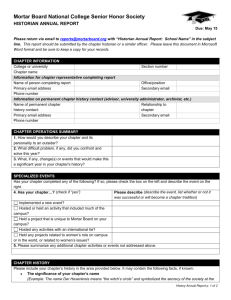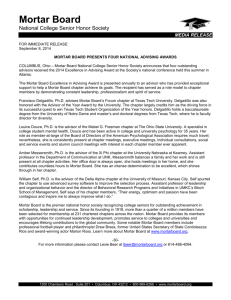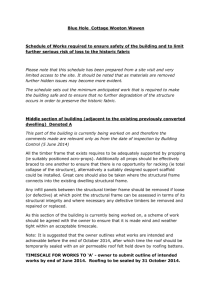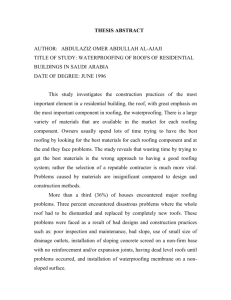Guide Specifications
advertisement
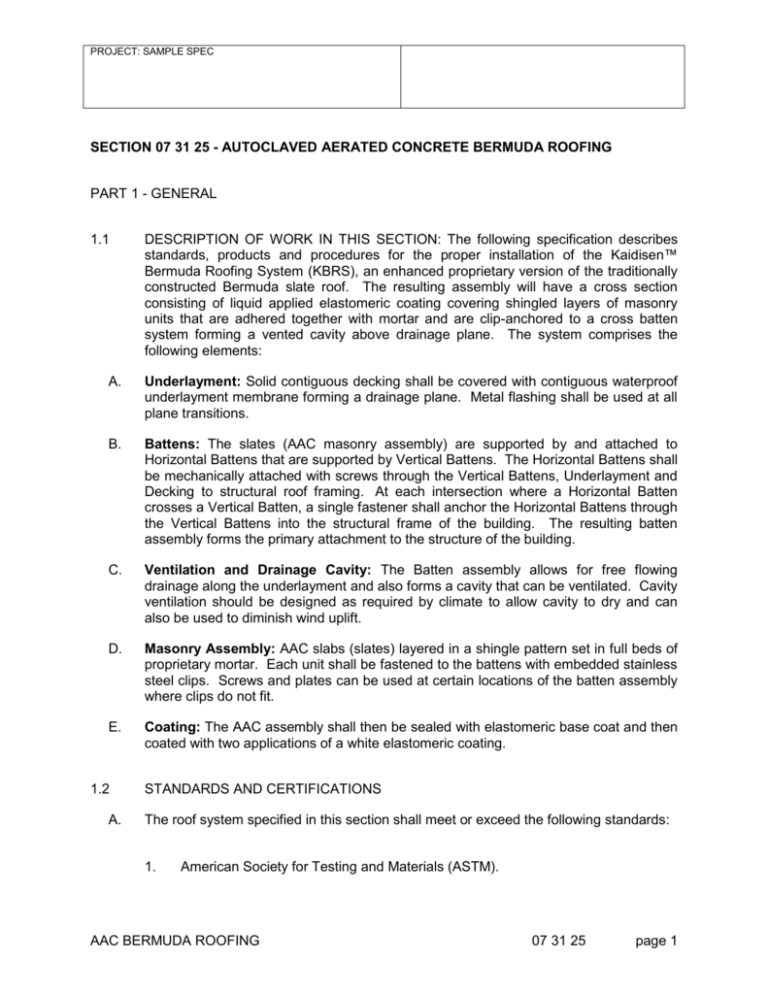
PROJECT: SAMPLE SPEC SECTION 07 31 25 - AUTOCLAVED AERATED CONCRETE BERMUDA ROOFING PART 1 - GENERAL 1.1 DESCRIPTION OF WORK IN THIS SECTION: The following specification describes standards, products and procedures for the proper installation of the Kaidisen™ Bermuda Roofing System (KBRS), an enhanced proprietary version of the traditionally constructed Bermuda slate roof. The resulting assembly will have a cross section consisting of liquid applied elastomeric coating covering shingled layers of masonry units that are adhered together with mortar and are clip-anchored to a cross batten system forming a vented cavity above drainage plane. The system comprises the following elements: A. Underlayment: Solid contiguous decking shall be covered with contiguous waterproof underlayment membrane forming a drainage plane. Metal flashing shall be used at all plane transitions. B. Battens: The slates (AAC masonry assembly) are supported by and attached to Horizontal Battens that are supported by Vertical Battens. The Horizontal Battens shall be mechanically attached with screws through the Vertical Battens, Underlayment and Decking to structural roof framing. At each intersection where a Horizontal Batten crosses a Vertical Batten, a single fastener shall anchor the Horizontal Battens through the Vertical Battens into the structural frame of the building. The resulting batten assembly forms the primary attachment to the structure of the building. C. Ventilation and Drainage Cavity: The Batten assembly allows for free flowing drainage along the underlayment and also forms a cavity that can be ventilated. Cavity ventilation should be designed as required by climate to allow cavity to dry and can also be used to diminish wind uplift. D. Masonry Assembly: AAC slabs (slates) layered in a shingle pattern set in full beds of proprietary mortar. Each unit shall be fastened to the battens with embedded stainless steel clips. Screws and plates can be used at certain locations of the batten assembly where clips do not fit. E. Coating: The AAC assembly shall then be sealed with elastomeric base coat and then coated with two applications of a white elastomeric coating. 1.2 A. STANDARDS AND CERTIFICATIONS The roof system specified in this section shall meet or exceed the following standards: 1. American Society for Testing and Materials (ASTM). AAC BERMUDA ROOFING 07 31 25 page 1 PROJECT: SAMPLE SPEC a. b. c. d. e. f. B. 1.3 A. 2. Florida Building Code High Velocity Hurricane Zone a. TAS 125 standard requirements for metal roofing systems b. TAS 123 standard requirements for mortar used in mortar set slate systems 3. Underwriters Laboratory a. UL 580 - Tests for Uplift Resistance of Roof Assemblies Class 90 b. UL 1897 - Uplift Tests for Roof Covering Systems 232 lbs using one clip per SF c. UL 1897 - Uplift Tests for Roof Covering Systems 262 lbs using two clips per SF d. UL 790 Standard Test Methods for Fire Tests of Roof Coverings Class A e. UL 2218 UL Standard for Safety Impact Resistance of Prepared Roof Covering Materials Class 4 Other standards referred to within this section: 1. Architectural Sheet Metal Manual - Sheet Metal and Air Conditioning Contractors National Association, Inc. (SMACNA). 2. The NRCA Roofing and Waterproofing Manual - National Roofing Contractors Association (NRCA), Fifth Edition. RELATED SECTIONS General: 1. 2. 3. A. ASTM 1386 – Standard Specification for Precast Autoclaved Aerated Concrete (AAC) ASTM E8 / E8M - 08 Standard Test Methods for Tension Testing of Metallic Materials ASTM C109 / C109M - 08 Standard Test Method for Compressive Strength of Hydraulic Cement Mortars (Using 2-in. or [50-mm] Cube Specimens) ASTM C1371-04—Standard Test Method for Determination of Emittance of Materials Near Room Temperature Using Portable Emissometers (.85) ASTM C1549 - 04 Standard Test Method for Determination of Solar Reflectance Near Ambient Temperature Using a Portable Solar Reflectometer (.75) ASTM D-6083 - Standard Specification for Liquid Applied Acrylic Coating Coordinate with trades completing structural work to ensure required conditions are provided necessary for the proper sequencing and installation of the roofing system specified within this section. Coordinate with trades completing work that penetrates or rises from roofing to ensure sequencing for proper completion of flashing. Coordinate with trades to ensure damage to completed roofing is prevented. Structural Requirements AAC BERMUDA ROOFING 07 31 25 page 2 PROJECT: SAMPLE SPEC General: Roof framing shall be installed according to governing building codes. 1. Roof structure – capable of design loads with less than L / 360 deflection. 2. Framing shall align accurately to form the planes and intersections of planes as shown on drawings. 3. Decking must provide a surface to support and hold the waterproofing membrane. 4. Typically set rafters or trusses 16 inches to 24 inches on center 5. Kaidisen™ Bermuda Roofing System is typically installed over a solid deck. Where wood framing is used, the system is typically anchored to the rafters through the decking. 6. Battens may be fastened to structural decking providing deck deflection is less than L/480 and pull-out resistance of batten fasteners meets the wind uplift requirements of the local code governing body. B. 1.4 A. Rising sidewalls shall be constructed to allow for water tight connection to roof. Typical details will involve concealed flashing connections at concealed primary drainage plane and secondary surface seals where exposed roof and wall surfaces intersect. QUALITY ASSURANCE Submittals: 1. 2. 1.5 A. 1.6 A. Shop drawing(s) showing critical flashing intersection(s) Data sheets and Samples: a. AAC units b. Mortar c. Clips d. Coating e. Sealants Set the standard for acceptance of construction quality and appearance early in the project with a mock-up. That is reviewed by all parties to the project. Laboratory analysis of the stored material or constructed work. QUALITY CONTROL Owner may engage the Architect or a qualified independent consultant or testing agency to perform full time construction monitoring or periodic inspection or field or l AAC BERMUDA ROOFING 07 31 25 page 3 PROJECT: SAMPLE SPEC PART 2 - PRODUCTS 2.1 A. 2.2 A. 2.3 UNDERLAYMENT SBS self adhering granular surface sheet 40 mils minimum. 1. ASTM D 1970 Specification for Self-Adhering Polymer Modified Bituminous Sheet Materials Used as Steep Roofing Underlayment for Ice Dam Protection. 2. Mastic and sealants conform to ASTM D 6152 Specification for SEBS-Modified Asphalt Used in Roofing. 3. Mesh to reinforce mastic: 4 inch wide rolls of 4.5 oz fiberglass mesh made of multi-strand, interwoven alkali resistant glass fibers FLASHING MATERIALS At all membrane perimeters and transitions: Sheet metal flashing shall be 304 or 316 stainless steel. (refer to Section 07 62 00) SLATE A. Kaidisen™ Slate are AAC masonry units 1 inch thick by 18 inches high by 12 inches wide, conforming to ASTM E-119 having typical compressive strength of 580 psi. B. Kaidisen Starter units: C. 2.4 1. Kaidisen AAC Starters. Preformed or milled AAC block shaped to accommodate architectural style of eave and provide starting angle for masonry assembly. 2. Alternate: Kaidisen™ Precast Concrete Starters dry-pack reinforced concrete pieces 18 to 24 inches wide by 12 to 16 inches tall with turned down exterior faces having typical compressive strength of 6,000 PSI. Kaidisen Gutter units: Where Bermuda style guttering is built into the roofing system use prefabricated triangular cross sectioned units either of AAC having typical compressive strength of 580 psi or of pea-stone aggregate concrete having typical compressive strength of 4,000 PSI. MORTAR AND CEMENTIOUS COATINGS AAC BERMUDA ROOFING 07 31 25 page 4 PROJECT: SAMPLE SPEC A. 2.5 A. Mortar: 1. Kaidisen™ Mortar - proprietary light weight mortar. 2. Kaidisen™ Fiber Bond - proprietary fiber reinforced mortar used primarily for patching and as a cementitious slurry coating to reinforce areas where tensile strength may be needed. ACCESSORIES Wooden Battens (vertical and cross battens) 1. Grade and Species: No. 1 grade southern yellow pine S4S, 19 percent maximum moisture content pressure treated with wood preservatives meeting building code compliance either by reference to American Wood Protection Association (AWPA – formerly the American Wood-Preservers’ Association) standards 2. Dimensions: 1 inch (actual thickness) x 2 inch (actual width). B. Screws and plates for starter course and to secure slates not possible to secure clip– #8 Type W bugle head coarse thread screws, 2 in. to 3 in. long with 0.355 in. head diameter with fluorocarbon coating and 1-3/4 in. diameter plastic cap C. Securement Clips: Kaidisen™ Clips: 1. Material: Type 304 Stainless Steel full spring temper meets ASTM E8 and ASTM A313-03. 2. Thickness: (0.135 inch). 3. Tensile Strength: 223.4 KSI. D. Reinforcing Mesh (1 cm x 1 cm) / mortar catching net: multi-strand, interwoven alkali resistant glass fibers. NOTE: for roofs designed for enhanced impact resistance, mesh quality, size and weight may vary. E. Kaidisen™ Vents set in the mortar bed to conduct air from the cavity to the exterior: 12 inch long x 4 inches wide x ½ inch thick corrugated plastic blocks.. See drawings for placement. F. Insect Proofing at eaves: Use Kaidisen Vent blocks or a screen or mesh or other method of keeping bugs out of the cavity such as 4 inch wide strips of nonwoven fiber mesh made of recycled high density polyethylene (HDPE), nylon, or polyester ½ inch thick. 2.6 COATING SYSTEM AAC BERMUDA ROOFING 07 31 25 page 5 PROJECT: SAMPLE SPEC A. Kaidisen™ Acrylic Base Coat (or equal). B. Finish coat – Kaidisen™ Elastomeric Roof Coating (or equal), alkali resistant, acrylic exterior latex finish containing proprietary non-toxic fungicide. Meets ASTM D6083. (or equal). AAC BERMUDA ROOFING 07 31 25 page 6 PROJECT: SAMPLE SPEC PART 3 - EXECUTION 3.1 GENERAL A. Handle and store materials carefully and prevent damage to installed system, provide temporary protection if necessary. B. When stocking roof and staging, load areas safely and securely. Avoid overloading structure. C. Layout and install roofing system components neatly and accurately achieving level courses. D. Run courses contiguously across hips and valleys at intersecting slopes of similar pitch. 3.2 A. 3.3 FIELD QUALITY CONTROL Provide only trained and experienced mechanics to install roofing system. INSTALLATION OF UNDERLAYMENT A. Install self-adhering sheets according to waterproofing manufacturer's written instructions and recommendations in ASTM D 6135. B. Clean, prepare, and treat substrates. Prepare, fill, prime, and treat joints and cracks in substrates. Remove dust and dirt from joints and cracks. Provide clean, dust-free, and dry substrates for waterproofing application. C. Remove ridges and projections; fill holes, and other voids to make substrate smooth before installing membrane. D. Bridge and cover movable deck-to-wall and deck-to-deck joints with bond breaker strip and overlapping sheet strips. Invert and loosely lay first sheet strip over center of joint. Firmly adhere second sheet strip to first and overlap to substrate. E. Layout membrane so that it sheds water to the exterior of the roof or to drains where it shall be connected according to approved shop drawing. F. Apply and firmly adhere sheets. Accurately align sheets and maintain uniform 2-1/2inch- minimum lap widths and end laps. Overlap and seal seams and stagger end laps. All laps shall shed water; laps bucking water will be rejected. AAC BERMUDA ROOFING 07 31 25 page 7 PROJECT: SAMPLE SPEC G. Prepare, prime, and seal inside and outside corners, vertical and horizontal surfaces, terminations, penetrations and drains according to ASTM D 6135. H. Seal bucking-water-laps with two plies of mastic and mesh. I. Maintain contiguous membrane. Patch holes, seal around penetrations. Wherever fasteners penetrate the waterproofing and are subsequently withdrawn, patch resulting holes with modified asphalt sealant. 3.4 FLASHING A. Install metal flashing at eaves, transitions of slope, rising conditions and around penetrations such as pipes and conduits. B. All metal flashing shall be concealed and installed at the underlayment level of the system. C. Install flashing to allow free downward flow of water. fasteners made of similar or compatible metals. D. Where metal flashing terminates above membrane, set metal in a bed of mastic and strip in edges of metal flashing with two plies of mastic and mesh. 3.5 Secure metal flashing with BATTENS A. Wood Battens shall be installed above the underlayment in two layers: the bottom layer are placed vertically and the top layer is placed horizontally. B. The first layer (Vertical Battens) shall be vertically oriented typically located over the structural rafters or trusses roof. Vertical Battens are installed over the underlayment. They support the Horizontal Battens keeping them off of the roof deck. The resultant cavity will promote ventilation and also provides a clear drainage path to the eave over the underlayment. Vertical battens are typically set directly over framing members. For spacing other than directly over framing consult an engineer. (Structural decking capable of holding fasteners and transferring required pullout resistance to structural framing may be determined adequate by responsible parties). C. The second layer of battens (Horizontal Battens) shall be set 9 inches on center perpendicular to the Vertical Battens. D. Set horizontal battens to establish course lines aligning them so tops of battens will support the tops of the slates. E. Carry Horizontal Battens level across adjacent hips and valleys where adjacent planes of roofing are of equal slope. Where hips and valleys are formed of adjacent unequal slopes, course lines will not carry from slope to slope; in such a case maintain level courses of 9 inches to the weather. AAC BERMUDA ROOFING 07 31 25 page 8 PROJECT: SAMPLE SPEC F. Do not fasten battens through sheet metal valley flashing. G. Do not allow battens to block invert of valleys or other drainage paths. 3.6 A. AAC MASONRY ROOFING General: 1. Wash off all dust from slate and starters with water before installation. 2. Install slate and starters in Saturated Surface Dry (SSD) condition. 3. Saw-cut slate, do not break with impact. 4. Mix mortar with slump range for optimal adhesion and cured compressive strength. 5. Optimal adhesion of slate to mortar is critical to the performance of this system. Back butter all mating surfaces. 6. Do not install system if ambient temperature is below 40 degrees F. 7. Protect completed work from freezing temperatures for 28 days. 8. Wet cure with plastic and burlap if completed work is exposed to excessively hot dry weather during the 28 day curing period. Monitor completed work for shrinkage during curing. 9. Do not allow excessive amounts of mortar to block drainage path at underlayment. 10. Do not allow mortar to block invert of valley. 11. For steep sloped application: a. Align slate courses typically to the top edge of the horizontal battens. b. Courses shall be laid straight and level and spaced 9 inches to the weather including the weather. c. Set units spaced a minimum of ¼ inch horizontally; fill head joints fully with mortar. d. Stagger vertical joints from course to course a minimum of 4 inches. e. Where adjacent slopes are equal and maintain courses contiguously across valleys and hips. AAC BERMUDA ROOFING 07 31 25 page 9 PROJECT: SAMPLE SPEC 12. B. C. For low sloped application: a. Layout slates on battens so that horizontal edges are fully supported staggering vertical joints a minimum of 4 inches. Mechanically fasten bottom layer according to schedule shown on drawing. b. Fully embed succeeding layer in a one inch thick layer of Kaidisen™ Mortar. c. Slope to drain can be made with framing or by use of mortar as light weight fill applied above slate. Starters: 1. Place starters at eaves aligning vertical edges on centers of vertical battens. Space from fascia to allow for drainage of the cavity. Use vent block at drainage space to prevent insects from infiltrating cavity. 2. Fully conceal the cavity and any metal flashing. Fasten each piece to the battens with four stainless steel screws and washers. Wherever screws penetrate starters, holes must be predrilled and over sized by a minimum of 150% of screw diameter. 3. Layout units so they are adequately supported by battens. necessary to support starters. 4. Space units horizontally a minimum of 3/8 inch filling head joints with mortar. Add battens as At typical field of steep roof: Lay slate in straight and level courses in a shingle fashion providing a maximum exposure between courses of 9 inches including the weather. Set each successive course in a full bed of mortar (1 inch thick). Employ the following Sequence of Installation: 1. Clean off slates with a hose as they are unpacked removing particles and soaking them thoroughly to produce a Saturated Surface Dry (SSD) condition before installing them. 2. Mix mortar by machine mixer or drill in bucket making only enough mortar that will be used within one hour. Mix 1 bag (1.1 CF) with approximately 3.5 gallons of clean potable water depending on the weather conditions and the temperature. Do not retemper mortar once it is begun to set up. 3. Smear mortar onto the new mating surface of each slate covering the concealed portion of each course working the mortar into the surface. AAC BERMUDA ROOFING 07 31 25 page 10 PROJECT: SAMPLE SPEC 4. Place mortar to form bed on upper half of slate to be covered. Finished bed once next slate is set shall be ¾ inch to 1 inch thick. 5. Embed reinforcing mesh into the smeared mortar allowing the mesh to overhang the top of the slate extending up the roof to the next batten. Staple the top edge of the mesh to the batten to prevent mortar from pushing the mesh down into the cavity. 6. Back-butter each slate with fresh mortar coating the lower mating surface and sides just before laying it into the mortar bed. 7. Apply mortar bed to upper half of slate below and set slate aligning it with the top of the next batten. Seat slates in mortar bed by moving them from side to side as they are pressed into the bed. 8. Lay each slate with its upper bottom edge directly over the upper top edge of its supporting batten ensuring full support of each slate by the battens. 9. If one edge of the slate is chipped or out of square, place the factory finished or still square edge on the batten leaving the broken end to rest on the mortar bed over the slate below. This ensures the slate will be firmly and fully supported by the batten. Fill in with mortar to compensate for the missing AAC. 10. Allow a minimum head joint width of 3/16 inch between laterally adjacent slates when seating the slate in to the bed joint and ensure head joints are fully packed with mortar. 11. After embedding the slate into the mortar bed insert a Kaidisen Clip over the upper edge of each slate. (If enhanced uplift requirements are indicated follow schedule provided on drawing). NOTE: Typically the field of the roof will require one clip per slate; edges and ridges may require additional clips. 12. Apply mortar to butts of AAC units and strike smooth with a trowel to form a fillet fully sealing off the butt end to form the traditional feature of the Bermuda Roof known as “The Weather”. 13. Smooth the exposed mortar of the “The Weather” with a steel trowel sealing surface with cement paste brought to the surface by the action of the trowel. D. Keep cavities clean of mortar droppings and other materials during construction. E. Stopping and Resuming Work: Rack back units; do not tooth. Do not retemper mortar with water once it has begun to set up. When resuming work ensure mating surfaces of slates and starters receiving fresh mortar are SSD. F. Clean surfaces as work progresses. Remove mortar fins and smears before tooling joints. AAC BERMUDA ROOFING 07 31 25 page 11 PROJECT: SAMPLE SPEC G. As the mortar sets, finish exposed mortar surfaces smoothing to achieve an even appearance. H. After mortar has set, grind or cut away rough edges fins and other protrusions from the surface using trowels and rasps to achieve a visually smooth surface. 3.7 VENTING A. Place eave vents behind starters closing off cavity to animals and insects but allowing air to flow into the cavity. Do not block drainage path. B. Place cavity vents as indicated on drawings in mortar beds during AAC assembly construction. Fully embed tops and sides of vent blocks in mortar keeping the ends open to allow air flow in and out of the cavity. C. Attic ventilation (if required) shall be separated from cavity ventilation by stainless steel sheet metal flashing. Kaidisen vent materials may be used in this separated system to vent attic. 3.8 COATING A. Apply coating system only after installed masonry system has cured for 28 Days. B. Preparation: C. 1. Grind off fins and protrusions, rub surfaces smooth with rasp and brushes. 2. Remove dust and particles from surface of assembly. 3. Temporarily plug drain leaders (this is especially important for those feeding potable water tanks) prior to application of coating; remove plugs only after coating is thoroughly dry. Apply 1 coat of Base coat: 1. D. Application & Clean Up: a. Apply Kaidisen Base Coat generously (approximately 1 gal per 100 SF minimum coverage) to prepared surfaces brushing it vigorously into the surface of the roof to optimize adhesion between the AAC, mortar and coating system. b. Allow 4 hours before recoating. c. Clean brushes and other equipment promptly with warm soapy water. Apply 2 coats of Kaidisen™ Elastomeric Roof Coating. AAC BERMUDA ROOFING 07 31 25 page 12 PROJECT: SAMPLE SPEC 3.9 1. Apply each coat to a wet film coat of 15 mils achieving a final two coat dry film of 15 to 20 mils. 2. Allow coating to fully dry between coats. a. Apply coatings only to dry surfaces and only when weather shall remain dry and above 50 degrees F for 24 hours. Do not begin coating just before or during wet weather or if temperatures are expected to fall below 50 degrees F within 24 hours. b. Clean up - Clean brushes, rollers and other equipment promptly with warm soapy water. SEALANTS A. Apply sealant to coated surfaces only. B. Fill sealant joints with backer rod to form properly proportioned sealant cross section. END OF SECTION AAC BERMUDA ROOFING 07 31 25 page 13


